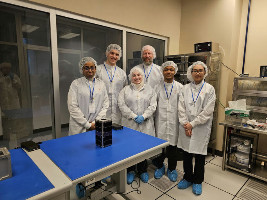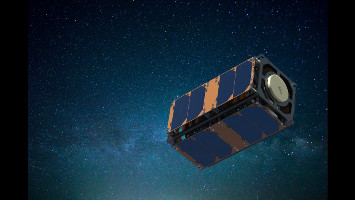| Satellite | VIOLET (CubeSat NB) |
|---|---|
| Spacecraft type | CubeSat |
| Units or mass | 2U |
| Status | Reentry 2024-08-29. No signal (Official news 2024-09-08) |
| Launched | 2024-03-21 |
| NORAD ID | 59596 ? |
| Deployer | NRCSD (NanoRacks CubeSat Deployer) [Quad-M] |
| Launcher | Falcon 9 (CRS-30) |
| Deployment | Deployed from ISS on 2024-04-18 |
| Organization | University of New Brunswick |
| Institution | University |
| Entity | Academic / Education |
| Country | Canada |
| Partners | University of Moncton |
| Oneliner |
Measure GPS signals after passing through atmosphere and several cameras for atmosphere and Earth imaging. |
| Description |
CubeSat NB will receive signals transmitted by global navigation satellite systems, such as GPS, as they travel through the ionosphere and are affected by it. Researchers will be able to use the data to further study how the ionosphere changes from place to place over time as well as how it responds to space weather. CubeSat NB will also carry three cameras. Two cameras will allow the team to study the distribution of oxygen in the upper atmosphere. The third camera will be used to take images of Earth’s surface for Earth science and meteorology applications. Knowledge of Earth’s oceans is critical to the understanding of climate change. The radio amateur purposes of VIOLET include allowing amateurs to communicate with other amateurs around the world in VHF, UHF and S bands as well as motivating the use of the S band amateur radio frequencies. Two communication systems on VIOLET that enable this are the VUB (VHF/UHF Board) and the SCP (SDR (Software-Defined Radio) Communications Platform). VHF is the uplink to the CubeSat and UHF is the downlink to Earth. S band is used both to the CubeSat and to Earth. There are technical investigations which have the overall theme of space weather. There are two mission payloads. One mission payload is called GRIPS (GNSS Receiver for Ionospheric and Position Studies) which will record and transmit raw GNSS observations to be used in the study of Earth’s upper atmosphere. The second mission payload, SASI (Spectral Airglow Structure Imager) records images of the middle and upper atmosphere to capture phenomena that occur here that affect the circulation of the atmosphere and the movement of the energy and constituents. |
| Results | |
| Notes |
One of 15 winners of Canadian CubeSat Project. |
| Sources | [1] [2] [3] [4] [5] |
| Photo sources | [1] [2] |
Last modified: 2024-12-16


